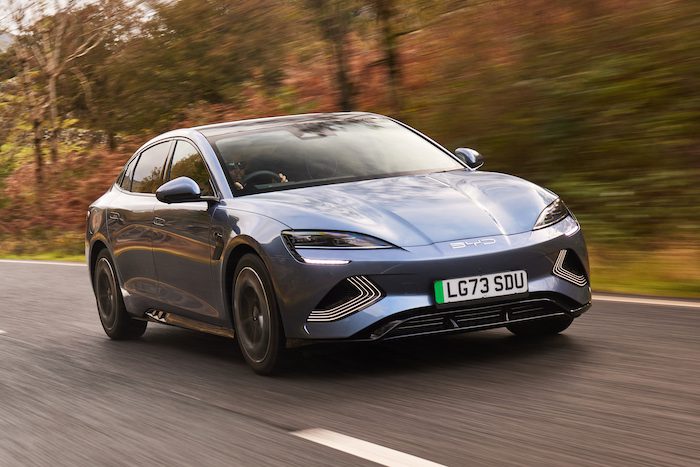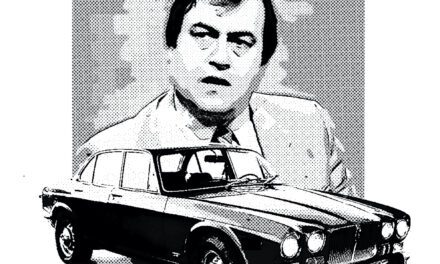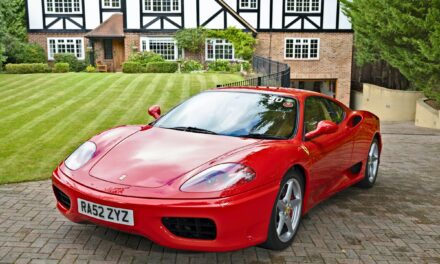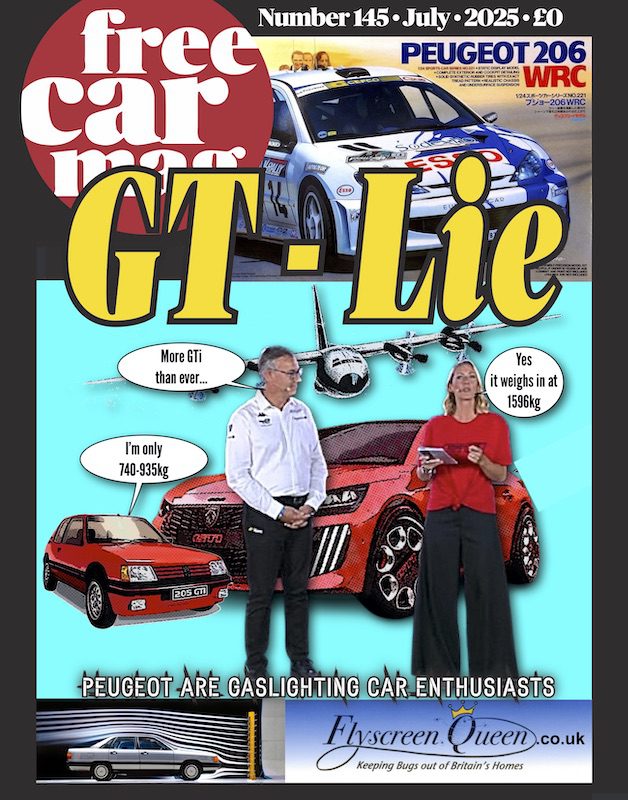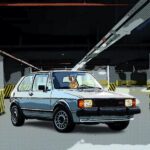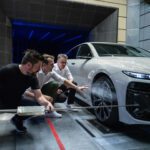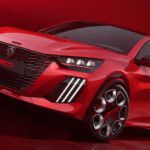It’s brand new, it’s electric, it’s Chinese and it’s inspired by the Ocean. Plus, it can accelerate from rest to 62mph in under four seconds, putting down over 500bhp through all four wheels. Meet the BYD Seal!
BYD is the biggest, fastest growing company, you never heard of, but which has left Elon Musk shaking his SpaceX as the Chinese upstart overtakes Tesla, to become the biggest seller of electric vehicles in the world.
In the UK we get the BYD Atto family SUV, the BYD Dolphin which is a city hatchback, and now this, an executive medium-sized four-door sports saloon, also fully electric. It is the second in what BYD calls its ‘Ocean series’ to arrive here (the Dolphin was the first) with the home market also getting the Seagull, a compact city car.
The vehicle is available in two variants: a rear-wheel-drive model with 313bhp and an all-wheel-drive version that boasts an impressive 530bhp, thanks to its dual motors. This latter variant can accelerate 62mph in a mere 3.8 seconds, showcasing the vehicle’s potent performance. So proud was BYD of this achievement, that they put a boastful badge on the boot! The ‘3.8S’ badge on the rear denotes not the engine size (as there is none) but the acceleration.
The rear-wheel-drive also sprints to 62mph in a pretty impressive 5.9 seconds, good enough for most dedicated sportscars. However, both are electronically limited to 112mph.
While the rear-wheel drive starts at £45,700, the AWD commands a three-grand premium at £48,700. However, considering the extra performance on tap, plus the security of the extra grip from all four wheels deploying traction; if you’re spending sub-50k on a car, you might as well get the top edition.
The BYD Seal is the first to be based on the company’s new E-Platform 3.0, featuring the innovative “Cell-to-Body” technology. This approach integrates the battery into the vehicle’s structure, enhancing its rigidity while maintaining a compact design. The Seal employs the Blade Battery technology, renowned for its efficient layout and cobalt-free composition.
It’s an 82.5kWh battery, capable of 150kW DC fast charging – although I used a public charger to juice it from 30% to 90% at 50kW and it took just over 70 minutes and cost £45. The indicated range was 250 miles (based on actual usage), but BYD claims official figures of 323 miles for the AWD and a little more for the lighter rear-wheel-drive at 354 miles.
The AWD weighs 2185kg while the 313bhp version is 2055kg. The Seal is 4800mm in length, 1875 in width and 1460 in height. The compact battery arrangement is said to make the car 10mm lower than would normally have been possible for an EV (remember the batteries are sandwiched in the floor).
While there are hints of Tesla in the design, it does very much have its own identity that draws on the ‘Ocean’ theme. The sleek wavy lines of the car itself, ending in the ducktail, give it an extraordinary drag coefficient of just 0.219CD.
At the front, there are ‘double-u’ floating LED headlights, and glistening ripple effect daytime running lights at the lower edges which are said to mimic ocean waves. On the flanks, there are distinctive shark fin blades and spectacular two-tone 19-inch rims. There is a light bar at the back, featuring motifs that suggest “the gentle patter of water droplets”.
The boot is deep, offers an underfloor compartment to store the cables, and there are 60:40 split-folding rear seats. If the 400-litres available is not enough, there’s another 53-litre storage bin in the ‘frunk’.
Slide into the cabin and in the rear, there’s good knee and headroom, comfy seats and ISOFIX child-seat anchor points, plus vents and USB sockets. This model has ‘vegan’ leather, and while space for your feet under the front seats might be a little tight, there is no sense of claustrophobia thanks to the vast panoramic glass roof, which adds to a sense of spaciousness.
Switch to the front and you’re greeted by a “surging wave” dashboard design, dominated by a 15.6-inch infotainment screen, along with a 10.25-inch instrument panel screen. The main central screen does the usual trick of rotating through 90 degrees at the flick of a button.
There are two wireless phone-charging pads, plus two USBs and a card slot, as well as Bluetooth connectivity. Oddly the Apple CarPlay doesn’t work unless the phone is cable-connected. The navigation appears only on the main screen, but there are no secondary directions on the instrument panel or the heads-up display, which this car also has.
It would take reams of text to go through all the features accessible from the central screen, from DAB radio (which kept cutting out on the move, so I resorted to ‘regular radio’ to exploit the 12-speaker excellent sound system), to cabin pollution filters (included PM2.5), configurable screen settings, smart charging, vehicle information and settings and more.
There are four driving modes, Snow, Eco, Normal and Sport, the last of which weights up the steering and makes the performance delivery more aggressive. As for that feature, the latent torque keeps a discreet profile. Until you really stomp on the throttle pedal, there is no inkling of the kind of speed this car can muster.
Sure, you’re never short of go when you need to enter a roundabout or launch out of a junction, but most of the time, you’ll not be aware of the electric muscle on hand. Unless an upstart in a Porsche pulls alongside, and then with the subtlest of grins, you select Sport and give the porker the shock of its life.
You’ll be appreciative of the beautifully contoured front seats, that provide great support, good headrests and comfort that’ll keep you fresh even after 8 hours in the seat, and I can testify to that. It took a while to get the right seating position though.
The steering, while insensate, is accurate and responsive, though it could have more heft to it. Grip is great, as you’d expect, and handling is pretty sure-footed.
Front visibility is decent, but it feels a little restrictive out the rear because of the slot-like back window. It has a full 360-degree camera view, including kerbside and of course reversing view. You can pull up the visuals with a button on the steering wheel, or whenever you indicate at low speeds. The car also has ultrasonic sensors and radars for the cruise control.
The ride is better than most EVs, although there remains unforgiving rigidity in the lower body, but generally, this is a quiet, serene and effortless car to get around in. You don’t have to relearn driving either, as it doesn’t offer the one-pedal model EVs often boast of.
The BYD Seal brings you a practical real-world futuristic driving experience in a package that won’t be alien to your expectations. It does everything well, adds some oceanic charisma and style, and convinces with its efficient competencies. If you’re thinking of a smart executive-level zero-emission saloon with some hidden performance, you need to put this on your shortlist.
visit BrownCarGuy.com or follow @BrownCarGuy on social media platforms.
BrownCarGuy.com
YouTube.com/BrownCarGuy
Facebook.com/BrownCarGuy
Instagram.com/ShahzadSheikh
Twitter.com/Shahzad_Sheikh

